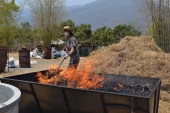Some great ideas already here. Because you may be new to comfrey - be aware that you
should select where you put it carefully, as it will be there forever (kind of like rhubarb), and the unless you get a sterile Russian/Bocking type, don't let it go to seed.
There's a great little known book called: How to Grow World Record Tomatoes: A Guinness Champion Reveals His All-Organic Secrets by Charles H. Wilber. It's quite amazing. If I remember right, he grows a winter cover crop of rye and fava beans, uses heavy
straw mulch (in his region, he's able to get kudzu hay - kudzu being a nitrogen-fixer - not that I recommend starting kudzu if it's not already in your region). He also plants annual peas or beans near his tomatoes. If you can get that book out of the library, it's well worth reading. Some of the ideas that he's come up with are pretty similar to
permaculture (don't cultivate the soil, plant a nitrogen-fixer nearby, mulch, drip irrigation). He gets monstrous growth by watching the plants carefully (measuring rate of growth), and adding light non-synthetic fertilizers when the plant looks like it may go into stress. It's very detailed, and one of these days after all my
trees and perennials are in, maybe I'll have time to watch my tomatoes as closely as he does/did (he was in his 80s when the book came out).
Just in case this is you: check if any trees nearby are black walnuts, butternuts, heartnuts, even hickories. If so - you'll have much better luck with tomatoes/potatoes/peppers, and numerous other plants in a
garden bed quite far from the tree. You can look this up, there is lots of info out there about the effects jugalone in walnuts has on neighbouring plants.

 1
1




 1
1




 1
1




 1
1




 1
1




 1
1




 1
1











